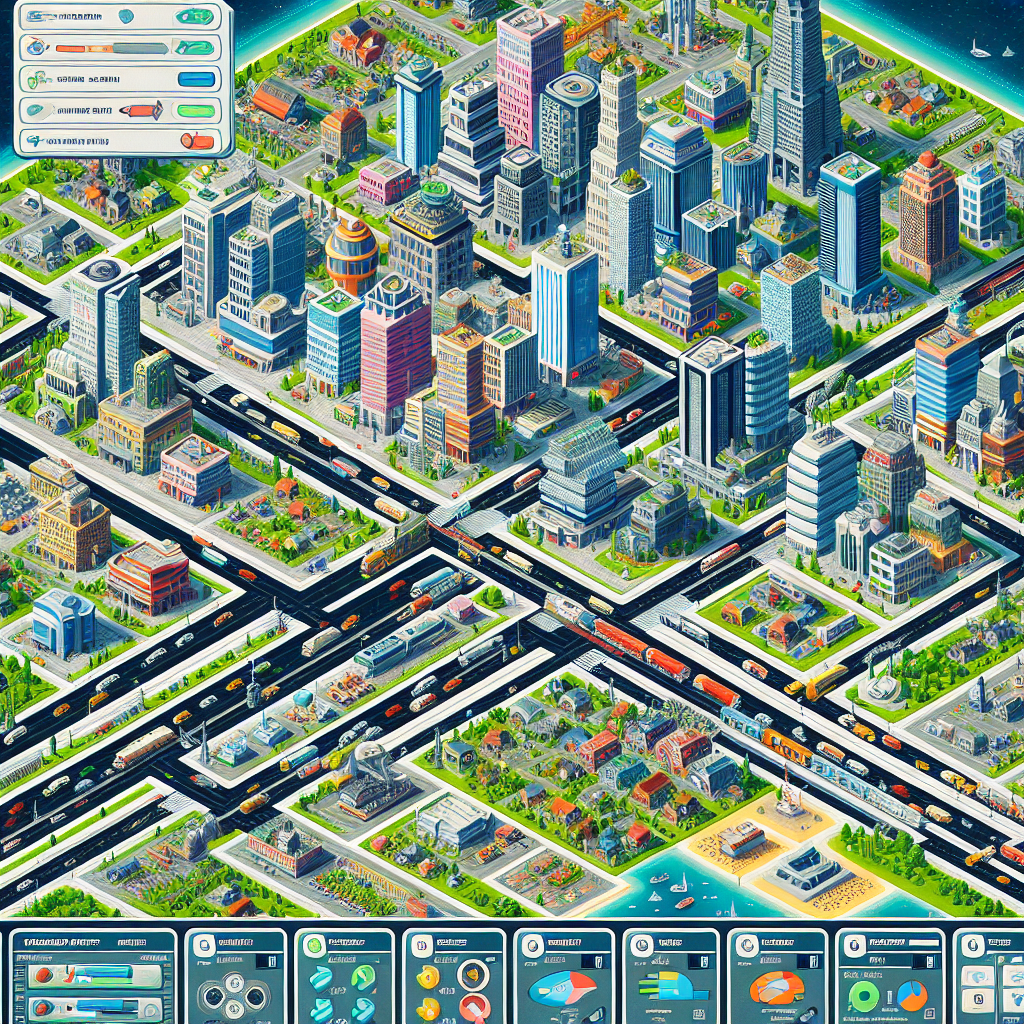SimCity BuildIt is a mobile simulation game developed by Electronic Arts, offering players the opportunity to build and manage their own city. Released as part of the SimCity franchise, the game provides a rich and engaging experience where players can design city layouts, manage resources, and address the needs of their citizens. With a rating of 4.3, SimCity BuildIt combines strategic planning with creative freedom, allowing players to construct skyscrapers, parks, and landmarks while balancing the economic and social aspects of urban development. The game features real-time challenges, multiplayer interactions, and regular updates, making it a dynamic and immersive city-building experience.
Strategies For Efficient City Planning In SimCity BuildIt 4.3
SimCity BuildIt, developed by Electronic Arts, offers players a dynamic and engaging city-building experience. As players navigate the complexities of urban planning, they must employ strategic thinking to ensure their cities thrive. Efficient city planning in SimCity BuildIt 4.3 requires a balance of resource management, infrastructure development, and citizen satisfaction. By understanding and implementing key strategies, players can create prosperous and well-functioning cities.
To begin with, resource management is fundamental to efficient city planning. Players must ensure a steady supply of essential resources such as water, electricity, and sewage systems. It is crucial to place these utilities strategically to cover the maximum area with minimal overlap, thereby conserving resources and reducing costs. Additionally, players should regularly upgrade their utility facilities to meet the growing demands of their expanding cities. By maintaining a balance between resource production and consumption, players can prevent shortages that could hinder city growth.
Transitioning to infrastructure development, it is essential to plan the layout of roads and transportation systems meticulously. A well-designed road network facilitates smooth traffic flow and reduces congestion, which in turn enhances the efficiency of emergency services and public transportation. Players should consider using a grid-based layout for their roads, as this allows for easy expansion and modification. Moreover, incorporating public transportation options such as buses and trams can alleviate traffic congestion and provide citizens with convenient travel alternatives. By prioritizing infrastructure development, players can create a city that is both functional and accessible.
In addition to resource management and infrastructure development, zoning plays a critical role in city planning. Players must designate specific areas for residential, commercial, and industrial purposes. It is advisable to separate industrial zones from residential areas to minimize pollution and enhance the quality of life for citizens. Commercial zones should be strategically placed near residential areas to provide easy access to goods and services. Furthermore, players should ensure that there is adequate space for future expansion and avoid overcrowding. By carefully zoning their cities, players can create a harmonious and efficient urban environment.
Citizen satisfaction is another vital aspect of efficient city planning. Players must address the needs and desires of their citizens to maintain a high level of happiness. Providing essential services such as healthcare, education, and public safety is paramount. Players should strategically place hospitals, schools, and police stations to ensure comprehensive coverage. Additionally, incorporating recreational facilities such as parks and entertainment venues can boost citizen happiness and attract new residents. By prioritizing citizen satisfaction, players can foster a thriving and contented population.
Moreover, economic management is integral to the success of any city. Players must generate sufficient revenue to fund city improvements and services. This can be achieved by balancing tax rates to ensure a steady income without overburdening citizens. Additionally, players should invest in commercial and industrial development to create job opportunities and stimulate economic growth. By maintaining a robust economy, players can support the continuous development and expansion of their cities.
In conclusion, efficient city planning in SimCity BuildIt 4.3 requires a multifaceted approach that encompasses resource management, infrastructure development, zoning, citizen satisfaction, and economic management. By implementing these strategies, players can create well-organized and prosperous cities that cater to the needs of their citizens. As players continue to refine their planning techniques, they will undoubtedly enhance their city-building prowess and achieve greater success in SimCity BuildIt.
Maximizing Resources And Currency In SimCity BuildIt 4.3
SimCity BuildIt, developed by Electronic Arts, is a captivating city-building simulation game that has garnered a substantial following. In version 4.3, players are tasked with the intricate challenge of managing resources and currency to create a thriving metropolis. To excel in this endeavor, it is essential to understand the various strategies and techniques that can maximize resources and currency, ensuring the efficient growth and sustainability of your city.
One of the fundamental aspects of SimCity BuildIt is the management of Simoleons, the primary in-game currency. Simoleons are crucial for constructing buildings, upgrading infrastructure, and purchasing essential items. To accumulate Simoleons efficiently, players should focus on maintaining a balanced economy. This involves ensuring that residential, commercial, and industrial zones are well-developed and adequately supplied with necessary services. By keeping your citizens happy and your city running smoothly, you can generate a steady stream of tax revenue, which is a significant source of Simoleons.
In addition to tax revenue, players can earn Simoleons by completing various tasks and challenges. These tasks often involve producing and delivering goods, which brings us to the importance of resource management. Resources such as metal, wood, and plastic are essential for manufacturing goods in factories. To maximize production, it is advisable to keep factories operating continuously. This can be achieved by planning production schedules and ensuring that raw materials are always available. By doing so, players can produce a surplus of goods, which can be sold for Simoleons or used to fulfill city needs.
Another critical resource in SimCity BuildIt is SimCash, the premium currency. SimCash can be used to speed up construction, purchase rare items, and expand city storage. While SimCash can be acquired through in-app purchases, it is also possible to earn it by completing achievements and participating in special events. To make the most of SimCash, players should use it judiciously, prioritizing essential upgrades and expansions that will have a long-term positive impact on the city’s development.
Moreover, the game features a trading system that allows players to buy and sell goods with other players. This system can be a valuable tool for acquiring rare items and resources that are otherwise difficult to obtain. By actively participating in the trading market, players can not only acquire necessary items but also earn additional Simoleons by selling surplus goods. It is important to monitor market trends and prices to make informed trading decisions, ensuring that you get the best value for your resources.
Furthermore, the introduction of the Contest of Mayors in version 4.3 provides an excellent opportunity for players to earn valuable rewards, including Simoleons, SimCash, and rare items. By participating in these contests and completing various tasks, players can climb the leaderboard and earn significant bonuses. It is essential to strategize and prioritize tasks that offer the highest rewards, maximizing the benefits gained from participating in the Contest of Mayors.
In conclusion, maximizing resources and currency in SimCity BuildIt 4.3 requires a strategic approach to city management, resource production, and economic planning. By maintaining a balanced economy, efficiently managing production schedules, participating in trading, and taking advantage of special events and contests, players can ensure the steady growth and prosperity of their city. With careful planning and strategic decision-making, players can create a thriving metropolis that stands the test of time.
Advanced Tips For Managing Disasters In SimCity BuildIt 4.3
In the dynamic world of SimCity BuildIt, managing disasters effectively is crucial for maintaining a thriving metropolis. As players advance to version 4.3, the complexity of disaster management increases, necessitating a strategic approach to ensure the city’s resilience. Understanding the nuances of disaster management can significantly enhance gameplay, allowing mayors to mitigate damage and expedite recovery.
To begin with, it is essential to recognize the types of disasters that can strike your city. These range from natural calamities like earthquakes and tornadoes to man-made crises such as monster attacks and UFO invasions. Each disaster type requires a tailored response strategy. For instance, earthquakes necessitate robust infrastructure and emergency services, while monster attacks demand a well-prepared defense system. By familiarizing yourself with the specific requirements of each disaster, you can allocate resources more effectively and minimize the impact on your city.
Transitioning to resource management, it is imperative to maintain a well-stocked inventory of essential supplies. This includes building materials, emergency kits, and repair tools. Having these resources readily available ensures that you can respond swiftly to any disaster. Additionally, investing in disaster preparedness buildings, such as fire stations, police departments, and hospitals, can significantly reduce response times and enhance the overall resilience of your city. These facilities not only provide immediate relief but also contribute to long-term recovery efforts.
Moreover, strategic city planning plays a pivotal role in disaster management. Designing your city with disaster resilience in mind can mitigate potential damage. For example, placing critical infrastructure away from high-risk areas can prevent widespread destruction. Similarly, creating buffer zones with parks and open spaces can absorb some of the impacts of natural disasters. By incorporating these elements into your city layout, you can create a more robust urban environment capable of withstanding various calamities.
In addition to physical preparations, fostering a strong community spirit is equally important. Engaging with your citizens and keeping them informed about potential risks can enhance their preparedness. Implementing public awareness campaigns and conducting regular disaster drills can ensure that residents know how to respond in an emergency. This collective readiness not only improves individual safety but also contributes to the overall resilience of the city.
Furthermore, leveraging technology can provide a significant advantage in disaster management. Utilizing advanced monitoring systems and predictive analytics can help identify potential threats before they materialize. By staying ahead of the curve, you can implement preemptive measures to safeguard your city. Additionally, integrating communication networks ensures that information flows seamlessly during a crisis, enabling coordinated response efforts.
As we delve deeper into the intricacies of disaster management, it becomes evident that a proactive approach is paramount. Regularly reviewing and updating your disaster response plans ensures that they remain relevant and effective. Conducting post-disaster assessments can provide valuable insights into areas for improvement, allowing you to refine your strategies continually. By adopting a cycle of continuous improvement, you can enhance your city’s resilience over time.
In conclusion, managing disasters in SimCity BuildIt 4.3 requires a multifaceted approach that encompasses resource management, strategic planning, community engagement, and technological integration. By understanding the specific requirements of each disaster type and implementing proactive measures, mayors can safeguard their cities and ensure a swift recovery. As players navigate the complexities of disaster management, these advanced tips can serve as a valuable guide, helping them build resilient and thriving metropolises.SimCity BuildIt by Electronic Arts is a highly engaging city-building simulation game with a rating of 4.3. It offers players the opportunity to design and manage their own city, balancing resources, and addressing the needs of citizens. The game features impressive graphics, a variety of building options, and social elements that enhance the overall experience. However, it also includes in-app purchases and can be time-consuming, which may not appeal to all players. Overall, it is a well-crafted game that provides a satisfying and immersive city-building experience.





